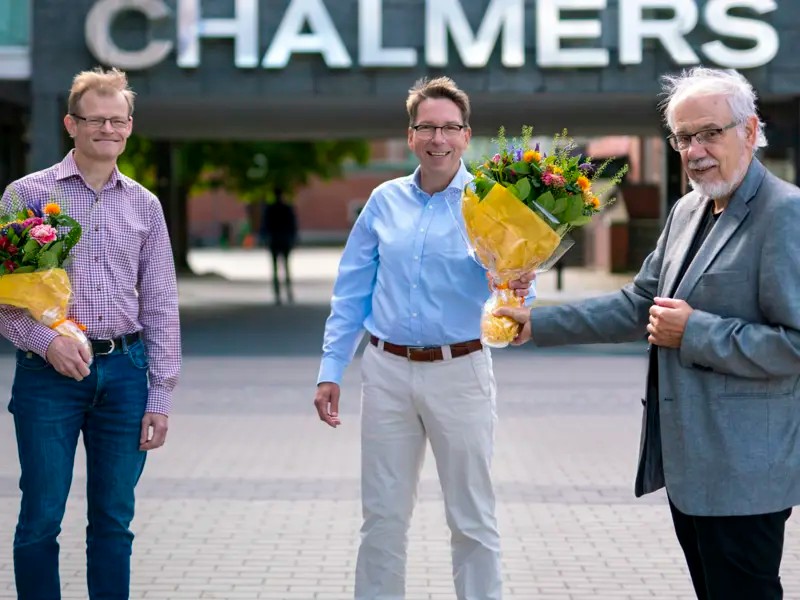During 2017-2021, Chalmers hosted two Vinnova competence centers in the area of wireless technologies for communication and sensing applications: GigaHertz- and ChaseOn. These centers were offered as an exceptional 5-year extension of their center predecessors GigaHertz- & Chase Center (2007-2016), based on their legacy of successful collaboration and knowledge transfer between industry and university.
The GigaHertz Centre has traditionally focused on semiconductor device and circuit-oriented research driven by long-term industrial and societal needs in wireless communication-, space-, and defense sectors. The ChaseOn Centre addressed antenna- and system-level research connected to needs in communication, sensing, industrial, and medical applications.
The GigaHertz and ChaseOn centres pioneered a new visionary form of collaboration in wireless system design. Driven by their early observation that future societal challenges could only be addressed within an ecosystem of complementary multi-disciplinary competencies and actors, these communities decided to operate the ChaseOn and GigaHertz Centres as a joint consortium. As a result, this consortium became Sweden's largest-ever academic-industrial collaboration platform in the wireless area and one of the largest in Europe.
Partners of the joint consortium
- Chalmers University of Technology
- Ampleon Netherlands B.V.
- Bluetest AB
- Elekta Instrument AB
- Ericsson AB
- Food Radar AB
- Gapwaves AB
- Gotmic AB
- Infineon Technologies Austria AG
- Keysight Technologies
- Kungliga Tekniska Högskolan (KTH)
- Low Noise Factory AB
- Medfield Diagnostics AB
- National Instruments Corporation (2017-2019)
- Omnisys Instruments Aktiebolag
- Qamcom Research and Technology AB
- Ruag Space AB
- Saab Aktiebolag
- Smarteq Wireless AB
- RISE Research Institutes of Sweden
- Virginia Diods (2020-2021)
Concrete examples how joint consortium research makes a difference
The success of such collaboration has been proven by research output, innovations, knowledge transfer, and new strategic initiatives. The key performance indicators and results are summarised in Table X.
Table X: Key performance indicators and results of the joint consortium
Goal | Definition | Description | Result | Target |
|---|---|---|---|---|
| Impact |
Success story approved by the Board | Documented industrial impact | 20 | 18 |
| Scientific publications | Refereed international journal / conference contributions | %: co-authorship academia + centre industriesr | 305 47% | 200 45% |
| Educated personnel | Examined PhDs from Chalmers (1 from KTH) | ( ): Hired by relevant industry | 18 (14) | 17 (11) |
What the international evaluators say
“The joint ChaseOn and GHz-Centre structure has proven to be a successful means to structure research, strengthen cooperation with industry and to use the available resources efficiently. The chosen governance structure, with two Centers governed by a single common Board, has proven to foster intense cooperation among the researchers in both centers, through synergies across the project landscapes.
They have succeeded in contributing state-of-the-art and even internationally leading scientific results. The clustering of the GHz and Chase-On centres has established a joint entity with outstanding expertise and capabilities in the field of microwaves and mm-waves. Beyond this, ISAB values the great industrial involvement in terms of budget and research input. The administration appeared to run very smoothly and supportive to the success of the centres.
It is notable how many Swedish startup companies were born from research roots and that these companies seem to have strong university links. This supports the view that universities are important in this regard and can be an enabling factor in innovation. The ISAB believes this experience in research and research management will enable the successful creation of next generation research centre or centres at Chalmers, also after the present GHz and Chase-On joint centre project has been completed.”
International Scientific Advisory Board
- Prof. Christophe Gaquière (Univ. de Lille, France)
- Dr. Riana H. Geschke (Fraunhofer FHR, Wachtberg, Germany)
- Prof. Wolfgang Heinrich (Ferdinand Braun Institut, Berlin, Germany)
- Prof. Christoph F. Mecklenbräuker (TU Wien, Vienna, Austria)

Areas of Advance Award for wireless centre collaboration
Collaboration is the key to success! In 2020, Profs. Jan Grahn and Erik Ström received Chalmers’ prestigious Areas of Advance Award for their efforts to merge the GigaHertz and ChaseOn wireless centers. The legacy of the joint ChaseOn and GigaHertz Centre consortium has bridged departments, researchers and colleagues across Chalmers and strengthened its international position in the area of industrially driven wireless research.